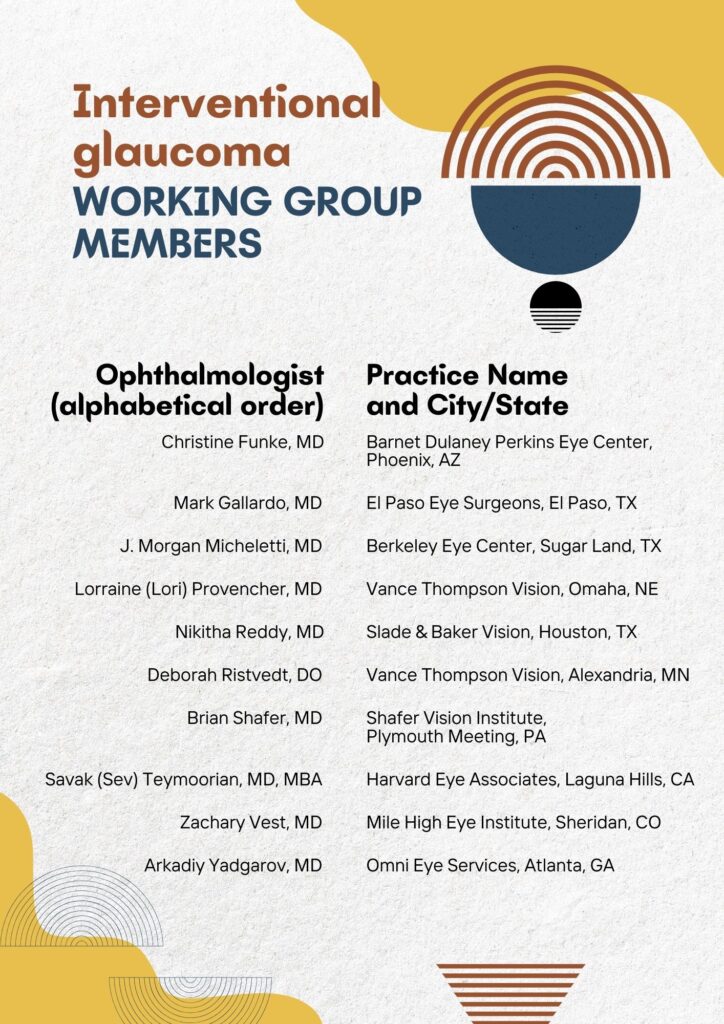The paper provides a detailed guide for moving away from glaucoma eye drops towards more proactive procedures.
The shift towards interventional glaucoma in modern ophthalmology marches on with the recent publication of a consensus treatment protocol.1
The consensus, authored by ophthalmic thought leaders like Drs. Morgan Micheletti and Christina Funke (United States), provides a first-ever structured treatment algorithm for modern interventional glaucoma treatments like lasers, minimally invasive glaucoma surgeries (MIGS), procedural pharmaceuticals and others.
The main goal of the paper is twofold: to recap the growing evidence base favoring interventional glaucoma, and to provide optimal treatment algorithms for the various glaucomatous disease states within the paradigm.
“Our newly published interventional glaucoma consensus introduces the first-ever structured, stepwise treatment protocol based on disease stage,” said Dr. Micheletti in a LinkedIn post announcing the publication of the protocol.
“This has never been done before—it’s a major shift toward interventional glaucoma management,” he emphasized.
The paper reflects the broader efforts of the Interventional Glaucoma Working Group, a collection of ten of the most prominent names in American glaucoma.

Table 1. Interventional glaucoma working group members. [Source]
Top takeaways from the interventional glaucoma protocol
The new consensus protocol provides distinct treatment pathways for four disease stages:
1. Ocular hypertension (elevated eye pressure without damage)
- First-line: Laser treatments (selective laser trabeculoplasty/SLT)
- Second-line: Procedural pharmaceuticals (travoprost intracameral implant/iDose TR, bimatoprost intracameral implant/Durysta)
- Third-line: Tissue-sparing MIGS
2. Mild glaucoma
- Slightly more emphasis on intervention to preserve visual function
- Similar pathway to ocular hypertension but adds non-tissue-sparing MIGS before considering maximum tolerated medical therapy
- First-line: Laser treatments
- Second-line: Procedural pharmaceuticals
- Third-line: Tissue-sparing MIGS
- Fourth-line: Non-tissue sparing MIGS
- Fifth-line: Maximal tolerated medical therapy (MTMT)
3. Moderate glaucoma
- Higher tolerance for the risks involved with more interventional procedures
- More willingness to use procedures that limit future procedural options
- First-line: Laser treatments
- Second-line: Procedural pharmaceuticals
- Third-line: Tissue-sparing MIGS
- Fourth-line: Non-tissue sparing MIGS
- Fifth-line: MTMT
- Sixth-line: Filtering surgery
4. Severe glaucoma
- Immediate combination therapy with procedural pharmaceuticals AND tissue-sparing MIGS
- More aggressive progression through treatment options to rapidly control pressure
- First-line: Procedural pharmaceuticals + tissue-sparing MIGS
- Second-line: Non-tissue-sparing MIGS
- Third-line: MTMT and/or SLT
- Fourth-line: Filtering surgery
What is interventional glaucoma?
Generally speaking, the interventional glaucoma that the paper champions indicates a move away from traditional, eye drop-based approaches to intraocular pressure management.
Interventional glaucoma methods typically favor more proactive approaches to treating underlying pressure-causing defects in the eye’s outflow pathway. These include surgical interventions (hence the name) like selective laser trabeculoplasty (SLT), MIGS procedures like canaloplasty and sustained-release drug implants.
The authors of the consensus highlighted the major advantages of the interventional approach in their Introduction.
“Substantial evidence suggests that proactive interventional approaches may enable more continuous 24-hour IOP control, improved compliance, delayed visual field progression, revitalization of the natural outflow pathway and reduced need for more invasive procedures.”
What the experts are predicting for interventional glaucoma
The working group anticipates that within 5-10 years, the standard of care will evolve beyond relying on topical medication as first-line therapy. They predict increased adoption of earlier diagnosis, better progression monitoring and prompt intervention using procedural options.1
“With this patient-centric perspective and minimally invasive treatment options, we can transform the traditional glaucoma treatment paradigm to significantly enhance patient outcomes,” the authors conclude.
“As a result, patients will benefit, health systems will bear a lower overall treatment burden, and increasing numbers of providers and patients will adopt an interventional approach to glaucoma treatment.”
Editor’s Note: This content is intended exclusively for healthcare professionals. It is not intended for the general public. Products or therapies discussed may not be registered or approved in all jurisdictions, including Singapore.
Reference
- Funke CM, Ristvedt D, Yadgarov A, Micheletti JM. Interventional glaucoma consensus treatment protocol. Expert Rev Ophthalmol. 2025;1-9.




